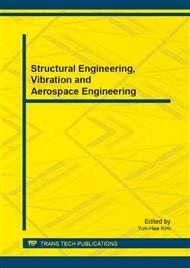p.141
p.145
p.150
p.155
p.163
p.169
p.174
p.179
p.183
A Design Method of Position Schemes for Particle Dampers Applied to a Flywheel
Abstract:
The design method research of position schemes for particle dampers applied to a flywheel under sinusoidal excitation has been investigated, in which discrete element method (DEM) and finite element analysis are used to study the relationship between the damping capacity of dampers filled with different metal particles and the dimensionless acceleration amplitude, and the specific parameter of radial position is introduced to discuss the influence on particle damping caused by different dampers attachment locations. A series of corresponding experimental investigation are conducted subsequently and the results indicate an auxiliary position scheme if the acceleration response of optimum location exceeds the threshold. It can be concluded that with the help of the specific parameter of radial position, the experiment results can be well explained, in addition, the design efficiency and accuracy will be raised, especially in the condition that the particles mass is strictly limited.
Info:
Periodical:
Pages:
163-168
Citation:
Online since:
December 2013
Authors:
Price:
Сopyright:
© 2014 Trans Tech Publications Ltd. All Rights Reserved
Share:
Citation:


